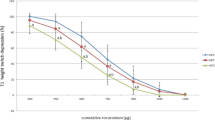Abstract
We examined the effects of enflurane on the diaphragmatic function in 15 pentobarbital-anesthetized, mechanically ventilated dogs. They were divided into three groups of five animals each, according to the administered concentration of enflurane. The diaphragmatic function was assessed from transdiaphragmatic pressure (Pdi) and integrated diaphragmatic electromyography (Edi) developed at functional residual capacity against an occluded airway during bilateral supra-maximal phrenic nerve stimulation at 0.5, 10, 20, 50 and 100 Hz under quasi-isometric condition. After a control measurement, enflurane was administered at a constant end-expired concentration (0, 0.5 and 1 MAC) and the measurement was repeated after 1 hour of exposure. The Pdi amplitude generated by single twitch (0.5 Hz) and during 10, 20 and 50 Hz stimulation was unchanged between the groups. No change in Pdi during 100 Hz stimulation was noted during 0 and 0.5 MAC exposure, while it was reduced by 1 MAC of enflurane. When the values of Pdi were expressed as % of maximum Pdi (%Pdi,max) that developed during control measurement and analyzed in terms of %Pdi,max — stimulus frequency relationship, a significant decrease in %Pdi,max was noted for 100 Hz stimulation in 0.5 and 1 MAC groups compared to the control. Similarly, Edi during 100 Hz stimulation obtained in 0.5 and 1 MAC groups was markedly depressed compared to the control. Edi during 50 Hz stimulation was also decreased at 1 MAC. Relative changes in Edi following enflurane administration. were greater than the corresponding changes of Pdi. These results demonstrate that enflurane impairs diaphragmatic function through its inhibitory effects on neuromuscular transmission.
Similar content being viewed by others
References
Kochi T, Ide T, Isono S, Mizuguchi T, Nishino T: Different effects of halothane and enfiurane on diaphragmatic contractilityin vivo. Anesth Analg 70:362–368, 1990
Edwards RHT: Physiological analysis of skeletal muscle weakness and fatigue. Cli Sci Mol Med 54:463–470, 1978
Jones DA, Bigland-Ritchie B, Edward RHT: Excitation frequency and muscle fatigue: mechanical responses during voluntary and stimulated contraction. Exp Neurol 64:401–413, 1979
Aubier M, Viires N, Murciano D, Medrano G, Lecocguic Y, Pariente R: Effects and mechanism of action of terbutaline on diaphragmatic contractility and fatigue. J Appl Physiol 56:922–929, 1984
Aubier M, Viires N, Murciano D, Seta J-P, Pariente R: Effects of digoxin on diaphragmatic strength generation. J Appl Physiol 61:1767–1774, 1986
Howell S, Fitzgerald RS, Roussos C: Effects of uncompensated and compensated metabolic acidosis on canine diaphragm. J Appl Physiol 59:1376–1382, 1985
Waud RE, Waud DR: Effects of volatile anesthetics on directly and indirectly stimulated skeletal muscle. Anesthesiology 50:103–110, 1979
Aubier M, Farkas G, De Troyer A, Mozes R, Roussos C: Detection of diaphragmatic fatigue in man by phrenic stimulation. J Appl Physiol 50:538–544, 1981
Jones DA: Muscle fatigue due to changes beyond the neuromuscular junction.Human Muscle Fatigue: Physiological Mechanisms, edited by Porter R and Whelan J, London: Pitman, 1981, pp. 178–190
Veber B, Dureuil B, Viires N, Aubier M, Pariente R, Desmonts JM: Effects of isoflurane on contractile properties of diaphragm. Anesthesiology 70:684–688, 1989
Dureuil B, Viires N, Nivoche Y, Ficks M, Pariente R, Aubier M, Desmonts JM: Different effects of halothane on diaphragm and hindlimb muscle in rats. J Appl Physiol 63:1757–1762, 1987
Clergue F, Viires N, Lemescle P, Aubier M, Viars P, Pariente R: Effects of halothane on diaphragmatic muscle function in pentobarbital-anesthetized dogs. Anesthesiology 64:181–187, 1986
Schnader J, Howell S, Fitzgerald RS, Roussos C: Interaction of fatigue and hypercapnia in the canine diaphragm. J Appl Physiol 64:1636–1643, 1988
Hussain SNA, Roussos C, Magder S: Autoregulation of diaphragmatic blood flow in dogs. J Appl Physiol 64:329–336, 1988
Author information
Authors and Affiliations
About this article
Cite this article
Kochi, T., Ide, T., Isono, S. et al. EnHurane supresses phrenic nerve-diaphragm Transmissionin vivo . J Anesth 5, 260–267 (1991). https://doi.org/10.1007/s0054010050260
Received:
Accepted:
Issue Date:
DOI: https://doi.org/10.1007/s0054010050260




